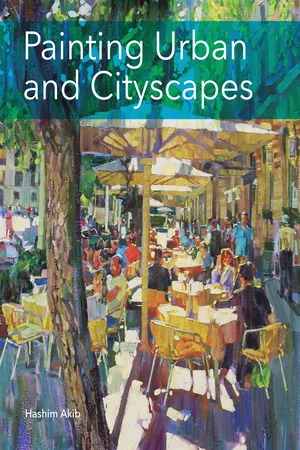
- 300 pages
- English
- ePUB (mobile friendly)
- Available on iOS & Android
Painting Urban and Cityscapes
About this book
Cities provide endless exciting scenes for the artist, from sun-baked cafes, rain-soaked streets, illuminated nightscapes and busy squares to quiet, atmospheric corners. This practical book explains how to paint these scenes using water-based painting materials and new techniques. With invaluable tips and advice throughout, it encourages a looser, more colourful approach to painting and shares a range of ideas for style and intepretation. Includes a guide to water-based mediums including acrylic, watercolour and mixed media, with advice on drawing, creative colour mixing and perspective. With step-by-step instruction to techniques, including tackling a street scene, and creating and capturing the movement of people, this inspirational book will help you capture the colour and movement of urban scenes and develop your own creative style of painting. Will appeal to all artists, architects, urban sketchers, interior designers and building companies.Superbly illustrated with 190 colour images.
Frequently asked questions
- Essential is ideal for learners and professionals who enjoy exploring a wide range of subjects. Access the Essential Library with 800,000+ trusted titles and best-sellers across business, personal growth, and the humanities. Includes unlimited reading time and Standard Read Aloud voice.
- Complete: Perfect for advanced learners and researchers needing full, unrestricted access. Unlock 1.4M+ books across hundreds of subjects, including academic and specialized titles. The Complete Plan also includes advanced features like Premium Read Aloud and Research Assistant.
Please note we cannot support devices running on iOS 13 and Android 7 or earlier. Learn more about using the app.
Information



1. | Pencil is your best starting point and comes in different grades from very hard to soft, providing a variety of tones from grey to very black. These are graded from H for hard to B for soft; a 2B or 4B is the most practical with which to begin. Putty rubbers are great if you need to erase any mistakes as no residue of the rubber remains. |
2. | Pen and ink also gives superior control but is less forgiving as marks cannot be erased. This can work to your advantage as it makes you more definitive and less reliant on constantly correcting mistakes. Your average ballpoint pen gives a consistent flow of ink but if you are looking for more irregular marks the nib pens come in different varieties. |
3. | Charcoal is the messier and grittier proposition in drawing. As the entire implement is the drawing tool, much more can be made of marks and tones. These are ideal for quick sketches but smudge easily if not fixed with spray fixative. Hairspray can work just as well for fixing charcoal and chalk pastel. |
4. | Coloured pencils and pastel pencils introduce colour, which can be layered in a very controlled way but can be timeconsuming. These pencils can work really well over a dry, light watercolour wash where elements can then be strengthened and refined. |
5. | Pastels and chalks provide blocks of colour which can produce incredibly smooth blends. Like charcoal, the nature of pastel does create a slightly unstable working surface that needs to be fixed with fixative. Again pastels can work well applied over initial washes of watercolour or smooth acrylics. |

1. | Watercolour is one of the most popular mediums and provides unrivalled subtlety from translucent layers, especially when using ‘wet on wet’ techniques. The paint comes in a variety of different-sized ‘pans’ or as tubes. Pans are exposed dry pigment that activates when water is added. It is the most unforgiving medium, which punishes severely for insecurities or mistakes. |

2. | Acrylics are the most versatile of all mediums. They have fast drying times and light washes can dry in minutes, with thicker applications drying in hours as opposed to oils, which can take days or weeks for layers to dry. Drying times are also dependent on the temperature of ... |
Table of contents
- Cover Page
- Title Page
- Copyright Page
- Acknowledgements
- Contents
- Introduction
- Chapter 1 Materials
- Chapter 2 Looking at Techniques
- Chapter 3 Composition and Drawing
- Chapter 4 Colour Mixing
- Chapter 5 Focus on Perspective
- Chapter 6 Simple Street Scene
- Chapter 7 Painting People
- Chapter 8 Weather
- Chapter 9 Busy Street Scene
- Chapter 10 Nightscape Cityscapes
- Chapter 11 Exploring Boundaries
- Glossary
- Index